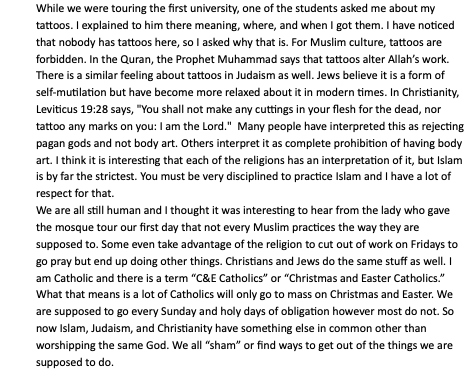The Practice of Islamic Prayer
The Practice of Islamic Prayer
The most important pillar of the Islamic religion is the performance of five daily prayers. In Ararbic this practice is called "salah," and in Morocco it is typically referred to as the "adhan." Salah is a term which signifies the act of getting closer to or convening with God. The practice of salah is highly structured: it is recited facing a certain direction at specific times of day and is typically accompanied by intentional physical movements to go along with the prrayer. These actions combined are believed to bring an individual closer to God whilst establishing group solidarity as it is often practiced in congregations (whether it be in a mosque, in the streets, etc.). The specific times of day at which the salah is recited are typically signaled by a call to prayer called the "adhan." Throughout history the adhan has been recited in Arabic by a "muezzin" in tall towers connected to mosques called "minarets." Today it is customarily recited inside the mosque and broadcasted to the public via speakers situated on the minarets. There are five ritual prayers that are performed daily, their names corresponding to the times of day that they are practiced: Fajir or Subduh (dawn), Zuhr (afternoon), Asr (late afternoon), Maghrib (just after sunset), and Isha (night). Each salah can be carried out anytime starting from the call to prayer until the next call to prayer. Often it is preferable to perform the salah in a mosque.
Across the world the broadcasting of the call to prayer or "adhan," on the minarets has been a point of contention between Westerners and Muslims. Ten years ago, politicians in Switzerland launched an initiative against the construction of minarets. Here in Morocco there is contention surrorrunding whether the broadcasting of adhan is deterring tourists. This religious fault line between the Muslim people and those with more secular beliefs is taking place within a context of a country that takes a very neutral / moderate stance on religious views and is allied with the United States at a time when there are fears surrounding al-Qaida's presence in North Africa. This tension is rife with undertones of islamaphobia and colonialism and is emblematic of both Morocco's unique struggle as well as the larger contextual religious ideological warfare which is occuring worldwide.
Ever since our arrival in Morocco I have been fascinated by both the minarets and the calls to prayer. As of this morning, Karlyn and I were awoken at 4 am to the sound of the adhan, which was a very surreal experience especially since I was under the assumption this wasn't customary. In my research, I discovered that in response to a French woman attempting to stop a neighboring mosque from broadcasting the adhan, that very mosque began broadcasting the call to prayer at 4:30 every morning. This piece of information made me wonder whether mosques throughout the country have been broadcasting the adhan at such an hour in response to the conflict at large. If this is true, what we heard this morning was symbolic of the aforementioned conflict.
Recommended Links
Uproar over prayer calls in Muslim Morocco
Swiss Ban Building of Minarets on Mosques



Fun facts about Islamic prayer and Islam in Morocco is that 99% of the Fez population is Muslim and about 50% actively practice with 5 times of daily prayer and this reduces crime in the cities. Due to religious guilt as they have to think about God at least 5 times a day.
ReplyDelete